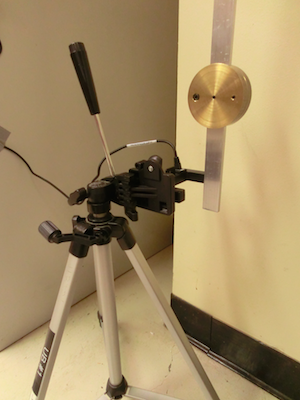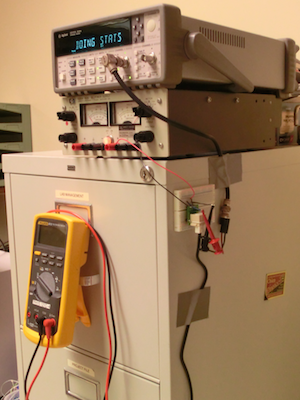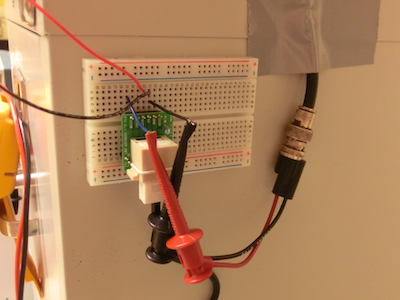Kater's Reversible Pendulum
Kater's pendulum is a very high-precision method of measuring local gravitational field. Our pendulum can measure the value of g to at least three decimal places, and possibly five. The apparatus consists of an aluminum bar in which are two precisely-spaced holes which serve as pivot points. The pendulum can be suspended from either of these pivot points, and the distance between the two pivot points is L = (40.375 +/- 0.002) inches at 28 degrees Celsius. There are five masses which can be moved along the bar: two brass masses of different sizes, two "floats" which are the same sizes and shapes as the brass masses, and an adjustable mass mounted on a micrometer screw. The positions of the masses are adjusted until the period of the pendulum is the same regardless of the pivot point used. When this condition is met, that period is equal to the period of a simple pendulum with a length L; g can then be calculated from the simple-pendulum equation.
The apparatus was built by Eric Ayars. It has been tested and is working as of 8/26/14. For best results, use only the smaller disk-shaped mass and float. (Remove the larger disk mass and corresponding float.) Place this mass and float near the pivot bushings initially: the crossover point is within 2cm of the bushing.
 |
 |
 |
Reading
- UConn Physics manual
- Colorado State's manual
- Follow the references in those two papers to learn more.
Questions
- Explain the purpose of the "floats".
- What are some ways of maximizing the accuracy and/or precision of this apparatus?
- What are some unavoidable sources of variability in your measurement of g? Is this apparatus sensitive enough to be affected by migrating birds? By current weather conditions? By nearby students? By the time of day?
Location
Room 108, West wall between rooms 108D and 108E.
Additional equipment needed
- Agilent 53131A (or equivalent) Counter/Timer
- Vernier photogate and breadboard adaptor
- 5V power supply
- Tripod to hold photogate
Cautions
- The apparatus is delicate, and is particularly flexible on one axis of the pendulum beam, so when reversing the pendulum be careful not to let it bend.
- Do not exceed 5V on the photogate supply.
- The threads in the floats are easily stripped, so be gentle with them.